| CEN4020: Software Engineering I |
up?
|
Eclipse and UML Tools
Contents
This is a basic introduction to the Eclipse IDE and Model
Developtment Tools (MDT).
There are many IDEs and UML tools, and UML tools integrated
into IDEs. Some of these cost money, and some are either entirely
free or available at little or no cost for student use. All of
them require an investment of time to learn. The more powerful the tool
larger the investments in time and money. In a business, these investments
will be paid off, in the long run, through increased
productivity.
In a university course, we have less time and money, and so
must make some compromises. We will limit ourselves to free
software. There are free UML tools, which can enable you to
produce better UML diagrams, help you catch some errors errors,
and make it easier to combine the work of team members at the end
of the term. You will need to decide how much time you want to
invest in learning such tools. A time investment up front may pay
off before the end of the course, and may pay off more later, if
you end up using the same or a similar tool after graduation.
There are several UML tools, which are either entirely free or
have a limited version available free for educational use. Since
different class members may be running Windows, Mac OSX, and
Linux, it is desirable that such a tool run on all three
platforms.
It is also desirable that all members of a team use the same
tool, so that UML can be combined and cross-checked by the
tool. At this point, it is not clear which of the available tools
is best. This may become apparent a bit later in the term, after
students have tried several and compared them.
The TA's for this course and I have tested several UML tools.
Two stand-along tools that seem easy to install and use
are BoUML and . However, it may be
better to consider using one of the UML tools that is integrated
with Eclipse.
Eclipse is well known and widely used open-source IDE, which
runs on many platforms, including Linux, MS Windows, and Mac OSX.
You can get information and free copies of the Eclipse code via
links from www.eclipse.org.
When I last checked there were 47
examples of Eclipse plug-ins that claim to support UML in some
form. Many of these are commercial products. Some are free. In
particular, there is a collection of UML tools that can be added
plugged into any Eclipse installation.
Information on some of the UML plugins for Eclipse
is provided below.
You may want to start with Lars Vogel's tutorial UML with
Eclipse Tutorial, which you may find useful. It is a little
includes some screen shots of
actual use, but is short of details on installation, saying just:
"The UML2 Tools can be found under 'Modeling' in the update manager.
Install the plugins via the update manager of eclipse."
The tool installation process will vary, depending on your
computer system, so that it is not practical to provide a single
generic "how to" explanation. I have installed Eclipse with UML
support on both my MacBook and my Gentoo Linux workstation, which
runs Gnome. I started by following the instructions I found on
the web for Eclipse, and succeeded in getting it up and running
pretty quickly.
Once you have some version of
Eclipse up and running, you can use the
built-in faculity for upgrades and plugin installations
to get UML capabilities, as follows.
Use the pull-down menu
Help?Install_New_Software to get the following
window. This screenshot shows what I got after clicking on the "V" icon
to select "http://downlaod.eclips.org/releases/galileo" from the
"Work with:" field, then scrolling the "Name" field to
the "Modeling" entry and then clicking the box to select it.
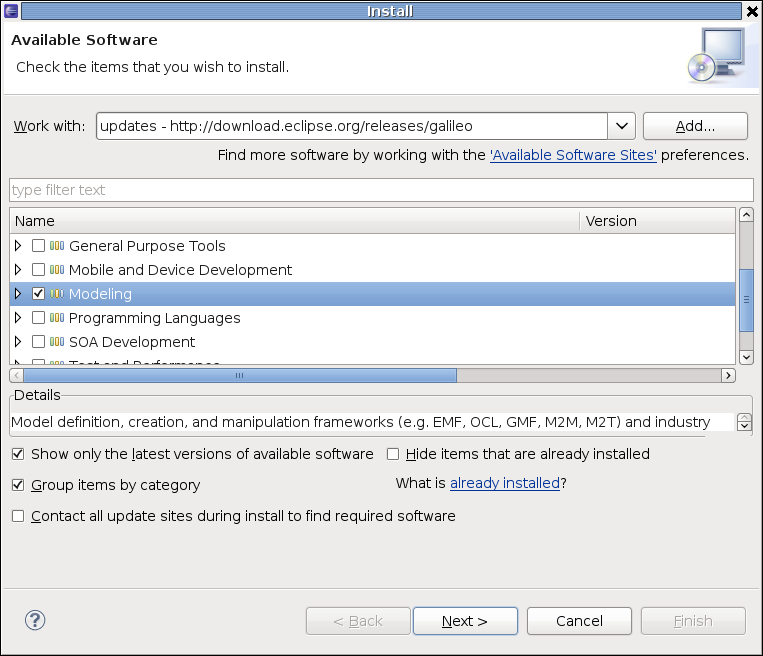
I then clicked on "Next>", and followed instructions until
the installation completed.
A lot seems to depend on how the built-in Eclipse
update/install mechanism is configured, by default, at the time of
installation. The set of update/install sites in the search list
seems to be critical. If you don't see anything in the "Work
with:" menu or it does not include any sites that have what you
want, you can click on the "'Available Software Sites'" link to
get the following screen, which will allow you to hand-enter some
URIs.
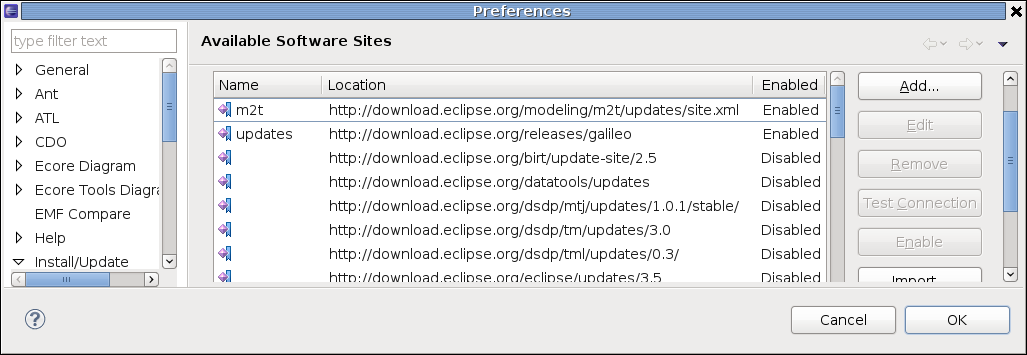
You can then use the "Add..." menu item to add URI's for update
sites. I found that
http://download.eclipse.org/releases/galileo was a
good starting point for my Eclipse 3.5 (Galileo) installation. However,
if you are using Eclipse 3.6 (Helios), you will find that the files are
not available on the update sites. You will need to follow
this
guide to manually add and install them.
If this still does not work, you may need to use the
Window?Preferences pull-down, then the
General?Capabilities pul-down, and check the
Classic Update box. (I did this during one of my
earlier unsuccessful experiments, and never set it back. I don't
know whether it made any difference in my later success.)
Now try creating a UML drawing. First use the
"File?New?Project..." menu item, select the
General?Project option, and give the name of the
project you want to create. If you give no name the name will be
"default".
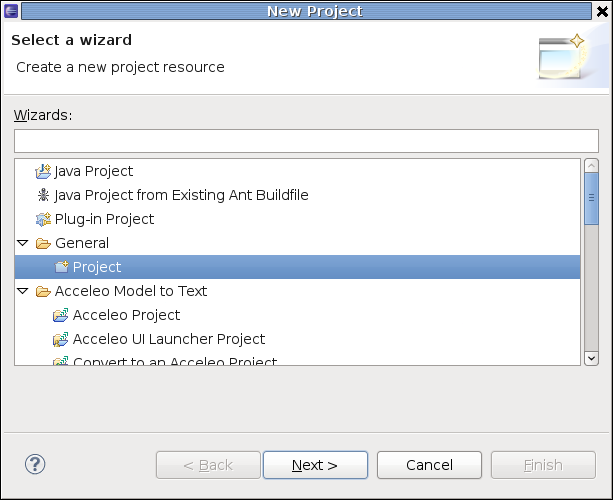
-
Then use the "File?New?Other..." menu
item, select the UML 2.1 Diagrams?Use Case Diagram option,
and provide a name.
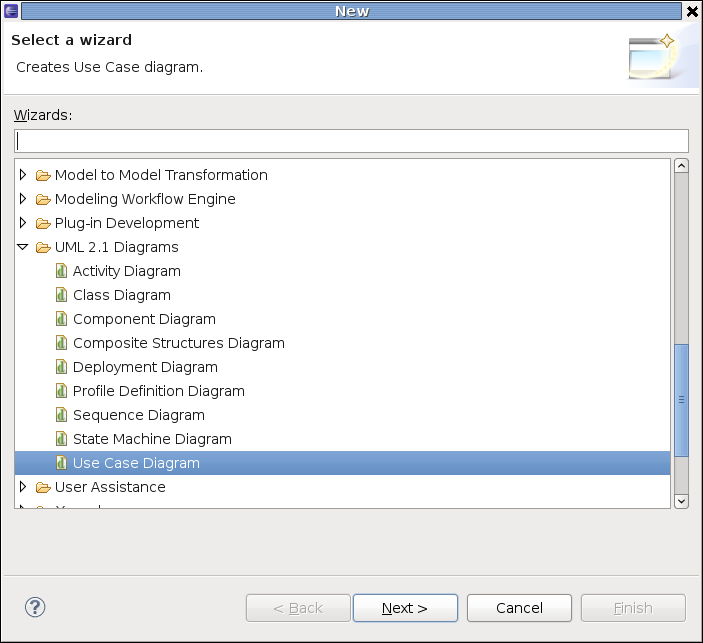
You should now be ready to draw. After minimizing some of
the many subwindows that Eclipse gives you by default, which you
can do using
the small horizontal bar icon near the right corner of each window,
you should have something like the following.
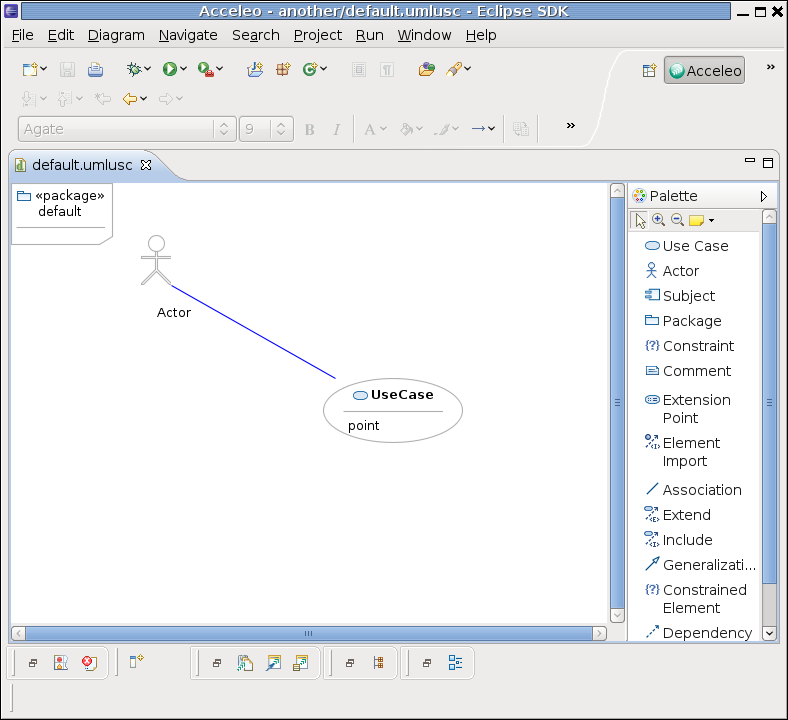
Enjoy.
There is an Eclipse plug-in called Papyrus
for UML, which is also available in a stand-alone version.
Robert Hall has tested this produced an Papyrus
tutorial.
Another Eclipse plug-in for UML is "UMLet".
You can download it from
http://www.umlet.com/umlet_10_4/com.umlet.plugin_10.4.0.jar.
By the way, if anyone is interested in using some heavy-duty
professional-grade commercial UML tools, by IBM/Rational, let me
know. I can get free copies of those, including the Rational
"Rose" modeling tool, for free educational use.
|
($Id: eclipse.html,v 1.1 2010/08/22 16:01:44 baker Exp baker $)
|




